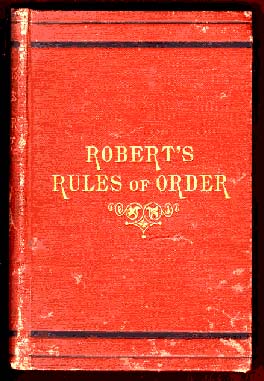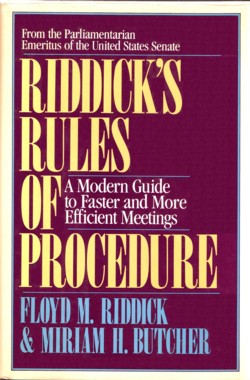Related Research Articles

Robert's Rules of Order, often simply referred to as Robert's Rules, is a manual of parliamentary procedure by U.S. Army officer Henry Martyn Robert. "The object of Rules of Order is to assist an assembly to accomplish the work for which it was designed [...] Where there is no law [...] there is the least of real liberty." The term Robert's Rules of Order is also used more generically to refer to any of the more recent editions, by various editors and authors, based on any of Robert's original editions, and the term is used more generically in the United States to refer to parliamentary procedure. It was written primarily to help guide voluntary associations in their operations of governance.

Parliamentary procedure is the accepted rules, ethics, and customs governing meetings of an assembly or organization. Its object is to allow orderly deliberation upon questions of interest to the organization and thus to arrive at the sense or the will of the majority of the assembly upon these questions. Self-governing organizations follow parliamentary procedure to debate and reach group decisions, usually by vote, with the least possible friction.
A repeal is the removal or reversal of a law. There are two basic types of repeal; a repeal with a re-enactment is used to replace the law with an updated, amended, or otherwise related law, or a repeal without replacement so as to abolish its provisions altogether.

The American Institute of Parliamentarians (AIP) is a not-for-profit educational organization founded in 1958. The objectives of AIP are to promote the use and teaching of parliamentary procedure, as well as the training and certification of parliamentarians.
In US parliamentary procedure, the previous question is generally used as a motion to end debate on a pending proposal and bring it to an immediate vote. The meaning of this specialized motion has nothing to do with any question previously considered by the assembly.

The Standard Code of Parliamentary Procedure is a book of rules of order. It is the second most popular parliamentary authority in the United States after Robert's Rules of Order. It was first published in 1950. Following the death of the original author in 1975, the third (1988) and fourth (2001) editions of this work were revised by a committee of the American Institute of Parliamentarians. In April 2012, a new book, entitled American Institute of Parliamentarians Standard Code of Parliamentary Procedure (AIPSC) was released, followed by a second edition in 2023.
In parliamentary procedure, reconsideration of a motion may be done on a matter previously decided. The motion to "reconsider" is used for this purpose. This motion originated in the United States and is generally not used in parliaments. A special form of this motion is reconsider and enter on the minutes.
In parliamentary procedure, an objection to the consideration of a question is a motion that is adopted to prevent an original main motion from coming before the assembly. This motion is different from an objection to a unanimous consent request.
In parliamentary procedure, a motion to appeal from the decision of the chair is used to challenge a ruling of the chair.
In certain countries, a motion in parliamentary procedure is a formal proposal by a member of a deliberative assembly that the assembly take certain action. Such motions, and the form they take are specified by the deliberate assembly and/or a pre-agreed volume detailing parliamentary procedure, such as Robert's Rules of Order; The Standard Code of Parliamentary Procedure; or Lord Citrine's The ABC of Chairmanship. Motions are used in conducting business in almost all legislative bodies worldwide, and are used in meetings of many church vestries, corporate boards, and fraternal organizations.
In United States parliamentary procedure, a suspension of the rules allows a deliberative assembly to set aside its normal rules to do something that it could not do otherwise. However, there are rules that cannot be suspended.
In parliamentary procedure in the United States, a motion to postpone to a certain time is used to delay action on a pending question until a different day, meeting, hour or until after a certain event. Then, when that time comes, the consideration of the question is picked up where it was left off when it was postponed.
Debate in parliamentary procedure refers to discussion on the merits of a pending question; that is, whether it should or should not be agreed to. It is also commonly referred to as "discussion".

Riddick's Rules of Procedure is a parliamentary authority - a book explaining the parliamentary procedure, including the rules, ethics, and customs governing meetings and other operations of the United States Senate. It was written by Floyd M. Riddick and co-authored by Miriam Butcher. The book is based on Riddick's experience as parliamentarian of the Senate as well as the procedures of assemblies using parliamentary manuals such as Robert's Rules of Order, and is arranged in a glossary style.
In a deliberative assembly, disciplinary procedures are used to punish members for violating the rules of the assembly.
In parliamentary procedure, requests and inquiries are motions used by members of a deliberative assembly to obtain information or to do or have something done that requires permission of the assembly. Except for a request to be excused from a duty, these requests and inquiries are not debatable nor amendable.
The history of parliamentary procedure refers to the origins and evolution of parliamentary law used by deliberative assemblies.
Parliamentary procedure is the body of rules, ethics, and customs governing meetings and other operations of clubs, organizations, legislative bodies, and other deliberative assemblies. General principles of parliamentary procedure include rule of the majority with respect for the minority.
In parliamentary procedure, the verb to table has the opposite meaning in the United States from that of the rest of the world:
References
- ↑ Gondin, William R. (1969). Dictionary of Parliamentary Procedure. Totowa, NJ: Littlefield, Adams. pp. 88, 90.
- 1 2 3 Robert 2011 , p. 15
- ↑ Sturgis, Alice (2001). The Standard Code of Parliamentary Procedure, 4th ed.
- ↑ National Conference of State Legislatures (2000). Mason's Manual of Legislative Procedure, p. 28–9
- 1 2 3 Robert 2011 , pp. 16–17
- ↑ Mason, p. 30
- 1 2 3 Slaughter, Jim; Ragsdale, Gaut; Ericson, Jon L. (2012). Notes and Comments on Robert's Rules (Fourth ed.). Carbondale and Edwardsville: Southern Illinois University Press. p. 160. ISBN 978-0-8093-3215-1.
- ↑ "Chris Dickey, Parliamentarian, Parliamentary Procedure Consultant". www.parliamentarian-chris-dickey.com.
- ↑ "Get The Right Book". The Official Robert's Rules of Order Web Site. The Robert's Rules Association. Retrieved 2021-02-20.
- 1 2 "Parliamentary Procedures: Interesting Facts and Tips", University of Illinois.
- 1 2 "Become a Parliamentarian - American Institute of Parliamentarians". American Institute of Parliamentarians. Archived from the original on 2016-02-19. Retrieved 2016-03-08.
- ↑ Jim Slaughter, "Businesses Must Follow Parliamentary Procedure Archived 2010-06-08 at the Wayback Machine ," Greensboro News & Record.
- ↑ "Rules and traditions of Parliament". www.parliament.uk. UK Parliament. Retrieved 2016-01-06.
- ↑ "Standing Orders - Glossary page". UK Parliament.
- ↑ Barnhart, Gordon. "Beauchesne's Parliamentary Rules and Forms, Fifth Edition, 1978". www.revparl.ca. Canadian Parliamentary Review. Retrieved 2016-01-06.
- ↑ Banks, Margaret. "New Insights on Bourinot's Parliamentary Publications". www.revparl.ca. Canadian Parliamentary Review. Retrieved 2016-01-06.
- ↑ Delorme, Michel. "Code Morin: procédure des assemblées délibérantes". www.gallimardmontreal.com. La librairie Gallimard de Montréal. Retrieved 2016-01-06.
- ↑ Elder, David Russell, ed. (2018). "House of Representatives Practice" (Seventh ed.). Department of the House of Representatives. Retrieved 2024-01-04.
- ↑ "Role of the Senate". www.aph.gov.au. Retrieved 2016-01-07.
- ↑ "What are the main authorities or references for meeting procedure in Australia and New Zealand | Master Of Meetings". masterofmeetings.com. Retrieved 2016-01-07.
- 1 2 3 "Mason's Manual for Legislative Bodies". www.ncsl.org. National Conference of State Legislatures. Retrieved 2016-01-05.